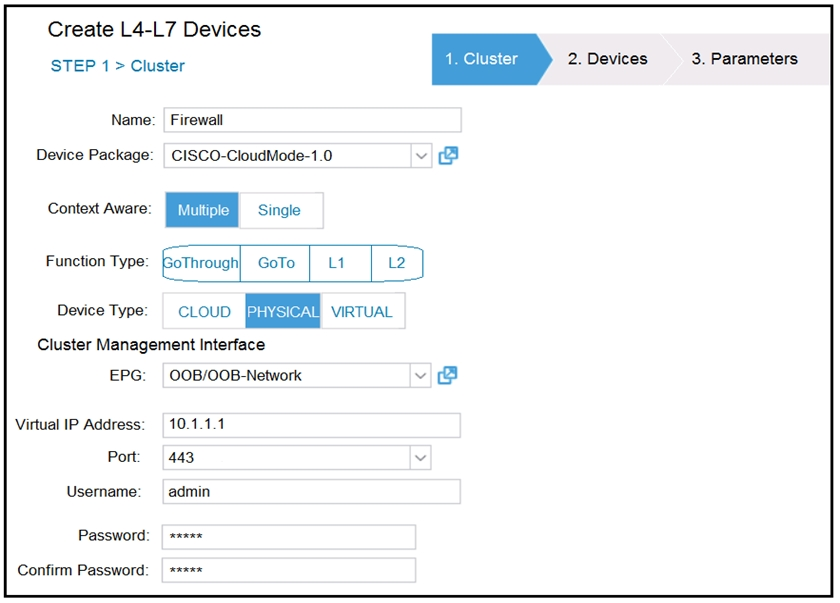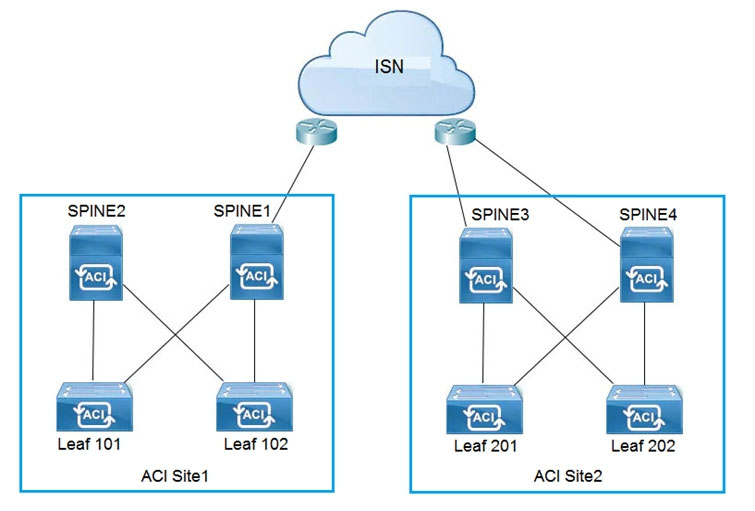Implementing Cisco Application Centric Infrastructure - Advanced (600-660 DCACIA) v1.0
Question 1
An organization expands a Cisco ACI Multi-Pod from two to six pods and must ensure that the control plane scales. What should be configured in the IPN to ensure that BUM traffic is forwarded efficiently across the IPN?
- A. spine headend replication
- B. BIDIR-PIM
- C. MP-BGP
- D. MSDP
Answer : B
Reference:
https://www.cisco.com/c/en/us/solutions/collateral/data-center-virtualization/application-centric-infrastructure/white-paper-c11-737855.html
Question 2
An engineer designers a Cisco ACI Multi-Pod solution that requires a pair of active-standby firewalls in different pods for external connectivity. How should the firewalls be implemented?
- A. PBR for routed firewalls
- B. separate L3Out peerings for routed firewalls
- C. routed firewall for the default gateway
- D. transparent firewalls
Answer : D
Reference:
https://www.cisco.com/c/en/us/solutions/collateral/data-center-virtualization/application-centric-infrastructure/white-paper-c11-739571.html
Question 3
How is broadcast forwarded in Cisco ACI Multi-Pod after ARP flooding is enabled?
- A. For the specific bridge domain, all spines forward the broadcast frames to IPN routers
- B. Broadcast frames are forwarded inside the pod and across the IPN using the multicast address that is associated to the bridge domain
- C. Within a pod, the ingress leaf switch floods the broadcast frame on all fabric ports
- D. Ingress replication is used on the spines to forward broadcast frames in the IPN infrastructure
Answer : A
Question 4
An engineer configures a Cisco ACI Multi-Pod for disaster recovery. Which action should be taken for the new nodes to be discoverable by the existing Cisco
APICs?
- A. Enable subinterfaces with dot1q tagging on all links between the IPN routers.
- B. Configure IGMPv3 on the interfaces of IPN routers that face the Cisco ACI spine.
- C. Enable DHCP relay on all links that are connected to Cisco ACI spines on IPN devices.
- D. Configure BGP as the underlay protocol in IPN.
Answer : B
Question 5
Which firewall connection allows for the integration of service nodes in transparent mode with a Cisco ACI Multi-Pod setup?
- A. active-standby mode across pods
- B. active-active mode per pods for communication between internal endpoints
- C. active-standby mode per pods for communication between endpoints and external networks
- D. active-active mode across pods
Answer : A
Reference:
https://www.cisco.com/c/en/us/solutions/collateral/data-center-virtualization/application-centric-infrastructure/white-paper-c11-739571.html
(table 1)
Question 6
An engineer configures a new Cisco ACI Multi-Pod setup. Which action should be taken for fabric discovery to be successful for the nodes in Pod 2?
- A. Select the Route Reflector field in Pod Peering
- B. Enable the DSCP class-cos translation policy for Layer 3 traffic
- C. Configure POD 2 Data Plane TEP under the Pod Connection Profile
- D. Add the IPN subnet under the Fabric External Routing Profile
Answer : D
Question 7
An engineer configures a new Cisco ACI Multi-Pod and must set up the link between the spine and the IPN device. Which three actions should be taken to accomplish this goal? (Choose three.)
- A. Enable MP-BGP routing
- B. Enable BIDIR-PIM protocol
- C. Enable PIM-SM protocol
- D. Enable OSPF routing
- E. Enable IS-IS routing
- F. Enable DHCP relay
Answer : ABF
Question 8
An organization deploys active-active data centers and active-standby firewalls in each data center. Which action should be taken in a Cisco ACI Multi-Pod to maintain traffic symmetry through the firewalls?
- A. Enable Endpoint Dataplane Learning
- B. Disable service node Health Tracking
- C. Enable Pod ID Aware Redirection
- D. Disable Resilient Hashing
Answer : B
Question 9

Refer to the exhibit. A network engineer configures a Layer 4 to Layer 7 device for an outside routed firewall that is connected to POD-1 inside a Cisco ACI fabric that consists of two pods. All traffic from POD-1 or POD-2 that uses the L3Out should pass through the routed firewall. Which Function Type must be implemented in the service graph for POD-2 to use L3Out?
- A. GoThrough
- B. L1
- C. GoTo
- D. L2
Answer : D
Question 10
What is the advantage of implementing an active-active firewall cluster that is stretched across separate pods when anycast services are configured?
- A. A different MAC/IP combination can be configured for the firewall in each pod.
- B. The local pod anycast node is preferred by the local spines.
- C. A cluster can be deployed in transparent mode across pods.
- D. Local traffic in a pod is load-balanced between the clustered firewalls.
Answer : A
Question 11
A network engineer configured an active-active firewall cluster that is stretched across separate pods in the Cisco ACI fabric. Which two implementation setups for anycast services are available? (Choose two.)
- A. Modify the Cisco ACI contract scope
- B. Modify the MAC address on the second firewall
- C. Configure the firewalls behind an EPG subnet
- D. Deselect No Default SVI Gateway under EPG Subnet
- E. Deploy a Layer 4 to Layer 7 service graph with PBR
Answer : BC
Question 12
An existing Cisco ACI Multi-Site setup with default fabric settings contains endpoints that communicate with an MTU of 1500. What is the minimum MTU value that must be supported by the ISN to allow control plane endpoint information exchange between sites?
- A. 9000
- B. 1554
- C. 9100
- D. 1600
Answer : C
Reference:
https://www.cisco.com/c/en/us/support/docs/cloud-systems-management/application-policy-infrastructure-controller-apic/214270-configure-aci-multi- site-deployment.html
Question 13
An engineer configures a new Cisco ACI Multi-Site Orchestrator node to join an MSO cluster. Which two components are necessary to ensure that the new node has IP connectivity in this configuration? (Choose two.)
- A. Cisco ACI spine interfaces that are connected to ISN
- B. Cisco APICs over the OOB management network
- C. existing Cisco ACI Multi-Site Orchestrator node
- D. management IP of ESXi hosts where the controllers are deployed
- E. OOB interface of ISN
Answer : BC
Reference:
https://www.cisco.com/c/en/us/solutions/collateral/data-center-virtualization/application-centric-infrastructure/white-paper-c11-739609.html
Question 14
In a Cisco ACI Multi-Site fabric, the Inter-Site BUM Traffic Allow option is enabled in a specific stretched bridge domain. What is used to forward BUM traffic to all endpoints in the same broadcast domain?
- A. ingress replication on the spines in the source site
- B. egress replication on the source leaf switches
- C. egress replication on the destination leaf switches
- D. ingress replication on the spines in the destination site
Answer : D
Reference:
http://yves-louis.com/DCI/?p=1277
Question 15

Refer to the exhibit. Which two configuration steps are required in ISN for Cisco ACI Multi-Site setup? (Choose two.)
- A. Connect Spine2 to ISN routers.
- B. Configure BIDIR-PIM throughout the ISN
- C. Increase ISN MTU to support the maximum MTU that is sent by endpoints
- D. Configure OSPF between spines and ISN routers
- E. Enable IGMPv3 on ISN routers
Answer : DE